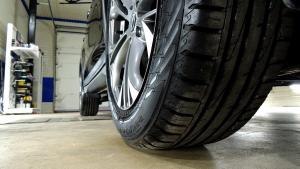Following the adoption last year of a methodology to measure the emissions from braking systems, UNECE’s World Forum for Harmonization of Vehicle Regulations (WP.29) now turns to tackling emissions from tyres.
Made from a mixture of natural and synthetic rubber and plastic polymers, including other chemical components, tyres represent a significant source of non-exhaust emissions.
Tyre abrasion is produced when there is friction with the road surface, for example when vehicles turn, accelerate or brake. Small particles break off from tyres (this is expressed as tyre weight loss) and are released into the air and onto the road surface and roadside environment. From there, they affect human health and can contaminate soil and waterways via road surface runoff, wastewater and airborne movement. They may eventually end up entering and polluting the ocean.
The Working Party on Noise and Tyres, with support from the Working Party on Pollution and Energy, today adopted a proposal to introduce two methods to measure tyre abrasion under UN Regulation No. 117:
-
On open roads in vehicle convoys driving 8,000 km;
-
In laboratories on an abrasing rolling drum over 5,000 km.
Tyre weight loss due to tyre abrasion will be expressed in milligrams per kilometer per ton of load on the tyre.
These measurement methods are expected to be applied in a market assessment exercise, aiming to collect abrasion data from diverse tyre sizes, patterns and brands. Such data would then be used to determine tyre abrasion limits to be incorporated in UN Regulation No. 117 by September 2025 for tyres fitted to passenger cars (C1 tyres).
Once these abrasion limits are in force, tyre manufacturers will need to ensure that all the tyres sold on the market are below the set limits. For those exceeding the limits, manufacturers will need to adjust their material composition or manufacturing process.
The proposal was prepared under the leadership of France and the European Commission and will become the reference methodology of the Euro 7 proposal of the European Union.
The measuring method is expected to be expanded to heavier vehicles with C2 and C3 type of tyres during 2026 and 2027 to cover most road vehicle categories.
Once in force, these regulations will contribute to significantly reducing microplastic pollution. In 2016, tyre abrasion was estimated to represent 78% of the 1.3 million metric tons of microplastics entering the ocean.
Note to editors
About the World Forum for Harmonization of Vehicle Regulations
The World Forum for Harmonization of Vehicle Regulations, hosted by UNECE, is a unique global platform responsible for the regulatory frameworks regarding the safety and environmental performance of vehicles, their subsystems and parts.
The World Forum manages three Global Agreements on vehicles: 1958 Agreement (UN Regulations); 1998 Agreement (UN Global Technical Regulations); and 1997 Agreement (UN Rules on Periodic Technical Inspections). Any country that is member of the United Nations may participate in the activities of the World Forum and accede to the Agreements.
The Working Party on Pollution and Energy (GRPE) is one of the six subsidiary bodies of the World Forum. It concentrates its work on defining exhaust, energy efficiency and power measurement procedures for all modes of inland transport in order to limit environmental damage.
The Working Party on Noise and Tyres is another subsidiary body of the World Forum that prepares regulatory proposals on vehicle noise and tyres for consideration and adoption by WP.29. To develop those requirements, GRBP conducts research and analysis.


